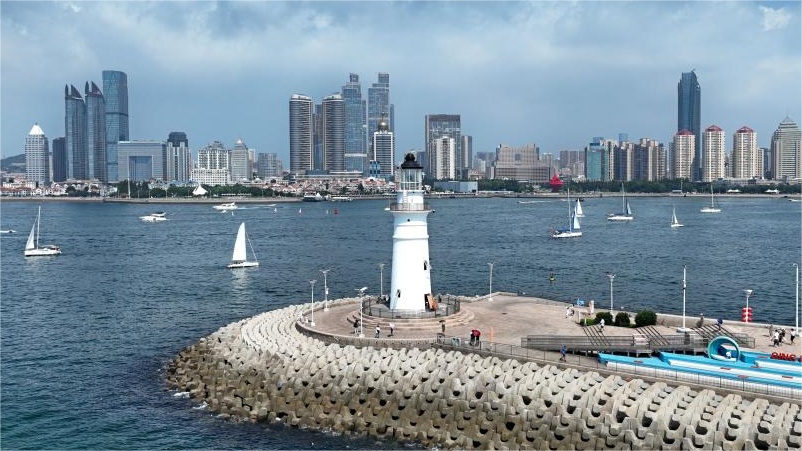Xinjiang Story: Aged coachman and his carriage bear witness to changes in historical quarter
URUMQI, Aug. 21 (Xinhua) -- When Kadir Zayir first took up the reins of his late father's horse-drawn carriage over 60 years ago, he did so with the aim of supporting his family.
In recent years, he has steered his own canopied horse-drawn carriage through the streets of Kazanqi, a historical quarter in the city of Yining in northwest China's Xinjiang Uygur Autonomous Region. Not only is Kazanqi his hometown, but also a national-level tourist attraction, attracting numerous tourists.
Kadir Zayir has spent most of his time giving tourists immersive rides through the multiple alleys, ancient buildings and courtyards of this vibrant folk tourism spot, accompanied by the jingling sound of the carriage bells.
In the Uygur language, Kazanqi means "people who earn a living by making cooking pots." Covering about 22.9 square km, Kazanqi is inhabited by people of various ethnic groups, including Uygur, Hui and Kazak. Uygurs account for 77 percent of the population.
"The roads in Kazanqi used to be particularly difficult to navigate and the houses in the quarter were mostly wood-and-earth residences, old and dilapidated. However, Kazanqi is growing increasingly beautiful, with better roads and more homestays," said Kadir Zayir, now in his 80s and recently retired from Kazanqi's horse-drawn carriage fleet.
Born in 1943 in Yining in Xinjiang's Kazak Autonomous Prefecture of Ili, Kadir Zayir grew up in a family of Uygur farmers. His family grew wheat and corn on 50 mu (about 3.33 hectares) of land, while his father drove a horse-drawn carriage transporting goods and passengers.
In 1958, his family moved into Kazanqi, where they lived in a wood-and-earth house lit by kerosene lamps, fetching water from a nearby creek.
"At that time, the roads were muddy and difficult to traverse. On rainy days, the horse's legs became covered in mud as it walked," he recalled.
Kadir Zayir said that despite the hardships, he never lacked the joys of childhood. He picked mulberries, played with rabbits and sometimes walked through the streets for about two hours to visit his friends after school.
In 1961, he drove his father's horse-drawn carriage for the first time, taking his friends to a river, some 5 km away from Kazanqi, to enjoy the scenery. Since then, steering the carriage has been an integral part of his life, providing his family with an income and his two daughters with an education.
As the tourism industry developed, transformations in Kazanqi began in 2007 when the local government invested over 100 million yuan (about 14 million U.S. dollars) in renovating and upgrading the quarter.
Since opening for business in 2008, the tourist spot has developed into a place for people to experience the traditional lifestyle of Xinjiang's ethnic minorities. It boasts cultural relics and architectural resources, including over 300 ancient buildings and nearly 20,000 residential courtyards.
Additionally, it features new attractions such as the horse-drawn carriage fleet, which was established by Kazanqi in 2008 to provide tourists with an immersive experience. The fleet initially consisted of four to five horse-drawn carriages, and its members were carefully selected by local tourism authorities.
Kadir Zayir was among the first batch of coachmen, all of whom were local residents. After being selected, he enhanced his carriage, decorating it with bells, a mattress and cloth made of Atlas silk, a local textile with bright colors and distinctive patterns, usually worn by Uygur women on special occasions.
Over the years, Kadir Zayir improved his standard of living by driving his carriage in Kazanqi, earning about 40,000 yuan every year, sufficient to support his extended family.
Shuttling back and forth in the quarter, he has witnessed the various transformations in Kazanqi. "The asphalt roads have reached the doorsteps of the houses, accompanied by electricity and tap water. Additionally, the houses have undergone renovations," he said.
He added that, with more tourists coming to the area over the years, he sometimes took his carriage out on tours 10 times a day, compared with two times a day in 2008.
Last year, Kadir Zayir sold his horse, and he retired this year. However, many more people and horses have joined the fleet, which currently boasts some 38 coachmen, as well as 15 horse-drawn carriages and 22 electricity-powered ones.
Among them is 22-year-old Mazir Erlan, who grew up on horseback in the pastoral areas in Xinjiang's Altay Prefecture. This year, he graduated with a major in tourism management from a junior college in Yining, and then came to work as a coachman in Kazanqi.
Despite being a newcomer, he has been able to introduce Kazanqi to tourists and mastered the skills of controlling horse-drawn carriages with precision. "Every aspect of Kazanqi is appealing to me, including its people, horses, scenery and environment," he said.
From January to July, Kazanqi received nearly 1.88 million tourist visits, up 34.12 percent year on year, according to statistics provided by the local tourism authorities.
(Chen Haiqi, Kong Weijia and Yang Zimeng also contributed to the story.)
Photos
Related Stories
- New air-cargo route links China's Xinjiang, Britain
- Xinjiang launches new TIR assembly center to facilitate cross-border trade
- Sand therapy turns Xinjiang's deserts into a tourist magnet
- Fresh delights, impressive scenery on southern Xinjiang's slow green train
- Creative combination 'Nang coffee' draws visitors in Xinjiang
Copyright © 2024 People's Daily Online. All Rights Reserved.









